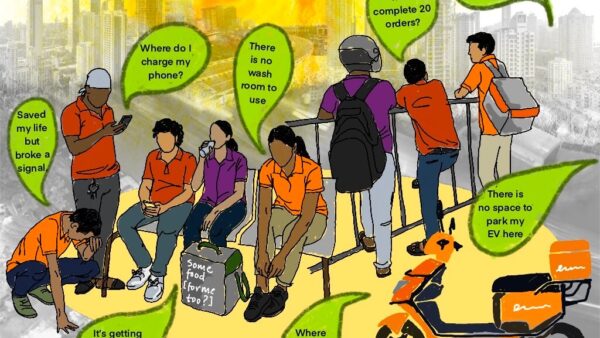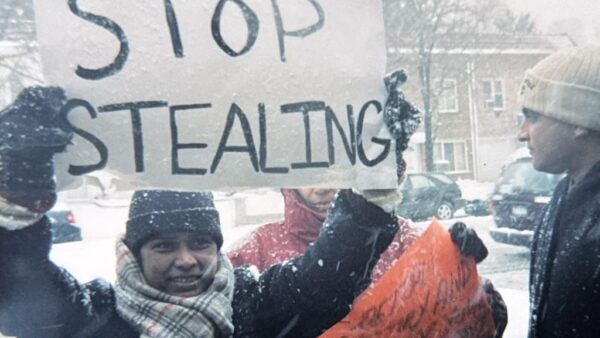When Jay Vyas, a 31- year-old marketing and media professional from Vadodara attended a programme organised by the civil society organisation ‘Voices of Vishwamitri’ in August 2021, he realised that he was joining a flow of efforts that had begun years earlier to save the Vishwamitri river and its ecosystem, around which Vadodara was built. Vyas is now a dedicated member of the organisation formed by Vadodara’s youth last year, which works to spread awareness about the river through music shows and lectures on the river’s Kala Ghoda Ghat.
Years before the city’s youth had woken up to the sorry state of the Vishwamitri, Vadodara’s academics had been alarmed by the Feasibility Report for the Vishwamitri Riverfront Development Project (VRDP). It was a wake-up call. When Shishir R Raval, the then head of the Architecture Department at the Maharaja Sayajirao University, first read the report in June 2014, he found many flaws. He wrote a petition to reconsider the proposal and offered to collaborate with the authorities for a more holistic approach. With inputs from Neha Sarwate, Raval’s colleague and a few other aware citizens, the petition was sent to the Commissioner of Vadodara Municipal Corporation (VMC) and other government authorities, including the then Chief Minister Anandiben Patel. The petition was signed by more than a hundred citizens. But, none responded.
Several of these aware citizens and activists were appalled that the proposal to revive a dying river, the backbone of the city, would involve concretising and channelising its course. Along with a few colleagues, Raval and Sarwate then called on the consultants working on this project to review and reconsider the ecological repercussions of this project but it only got a polite discussion. Then, they realised that a writ petition was the only way to get the authorities to listen.
Petition to the National Green Tribunal
Raval knew Rohit Prajapati and his wife, late Trupti Shah, environmentalists of the Paryavaran Suraksha Samiti. They were key members of the Narmada Bachao Andolan. They have been a known voice for environmental issues in Gujarat. Prajapati, Sarwate, Raval, Smita Pradhan, and Sonia Nair prepared a writ petition. Prajapati, Shah, Sanjay Soni, Surekha Sule and Pratik Lakdawala, all long-time residents of Vadodara, signed the petition. And, with assistance of Mumbai-based environmentalist and lawyer Lara Jesani, who was working on Prajapati’s other cases, the petition was filed with the Pune bench of the National Green Tribunal (NGT) in 2015. The petition contended that the Vadodara Municipal Corporation (VMC) had not sought environmental clearances or planned a wholesome ecological restoration of the river while planning the riverfront.
In an order dated May 25, 2016, the NGT restrained the VMC from proceeding with development activities within the area of the Vishwamitri Riverfront Development Project. “The court saw that our arguments were backed by logic and science. Our documentation was strong and we represented it with a timeline of events with imaging of the river’s course being changed and the debris being dumped,” Jesani told Question of Cities.
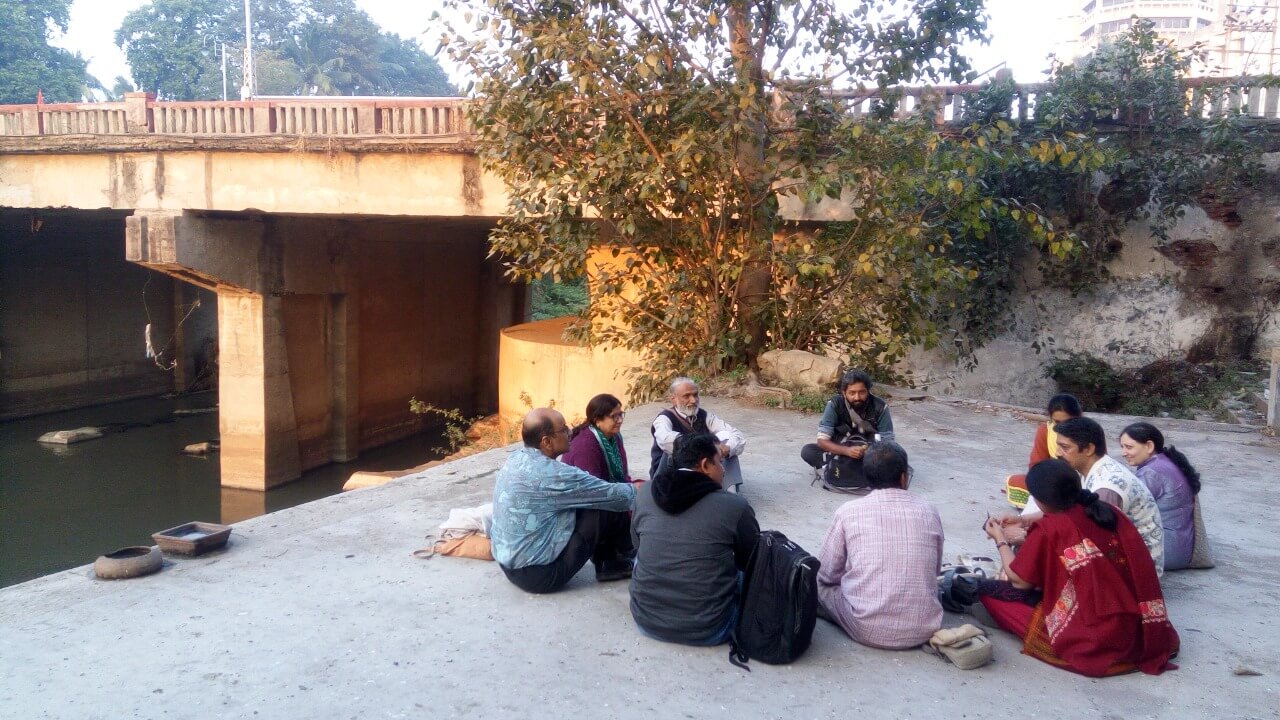
Photo: Neha Sarwate
However, the elation was short-lived. Despite the order, the VMC did not cease construction work on the riverfront. In October 2016, Jesani filed a contempt of court case on behalf of Prajapati and others. The NGT ordered a committee to be formed with the petitioners on it to check that its orders were complied with. The committee included BN Navalawala, then the advisor to the Gujarat CM. It was on this committee that Sarwate and Raval, along with several local academics and activists, kept up the heat on the authorities and asked questions about the ecological repercussions of the Vishwamitri Riverfront Project.
“The committee asked us to come up with an alternative in three weeks. And we did, we had a conceptual proposal ready in three weeks,” said Sarwate triumphantly. During this time, VMC withdrew their pending request for an Environmental Impact Assessment (EIA) with the NGT. Sarwate added, “The initial NGT order supported by our alternative proposal really put pressure on the authorities to stop the work.”
Other local NGOs such as ‘SOCLEEN’ and the ‘Vaho Vishwamitri Abhiyan’ used the available materials and sought expert inputs to make separate representations to the government against the proposed VRDP. Several active members and diverse groups of people decided to form the ‘Concerned Citizens of Vadodara’ (CCV) in 2017 and built up the pressure. In July 2017, the VRDP was finally scrapped to make way for a river rejuvenation project.
Sarwate recounts how local politicians tried to break up the group by approaching individuals in the CCV to come with demonstrative projects to address the issues more ecologically. She adds, “They would offer incentives to distract us. Everybody who went that way learnt lessons the hard way. Some of us discussed it openly. Even if we thought a politician’s approach to this movement was purely for the river, we would tell them the terms and conditions under which they could have our support and they would themselves withdraw their offers.”
Beyond the legal route
While the NGT case was still being fought, the team which by then had academics and students held discussions and deliberations with citizen groups at various venues – clubs, Gujarat Ecology Society, Community Science Centre, and so on. They also made a documentary called ‘Save Vishwamitri, Save Vadodara’ available in English and Gujarati on YouTube. “We would have panels where experts would talk about the river and the floor would be opened up for questions. We spread the word about these discussions through our personal contacts,” says Sarwate.
Several residents of Vadodara would contact Rohit Prajapati when their localities used to flood. They believed that the authorities listened to him, he would get them to show up for the discussions on Vishwamitri. Prajapati believes that organising people in various pockets across the city is more important than protesting. “We don’t protest at nukkads. We conducted meetings by the river, in societies, with students, professors and concerned citizens,” he said and added that the number of people who attended these meetings didn’t matter as long as they showed up. “We conducted meetings with two people, four people, and even 200 people. We only ensured that there is constant engagement. And this kind of struggle through the education of the common people with the help of experts was going on for decades. The riverfront plan came up later.”
Shishir Raval has been conducting design and research projects on the Vishwamitri river system since 1998. He was a key member in preparing the ‘Vision Vishwamitri Project’. He said that the world over, people look at rivers as whole systems unlike in India where only the river’s waterfront is taken into consideration. “Vishwamitri can survive without my intervention now. Our future generations and the future generations of all other species need to have this river for their survival. The city of Vadodara needs this river to survive,” said the academic.
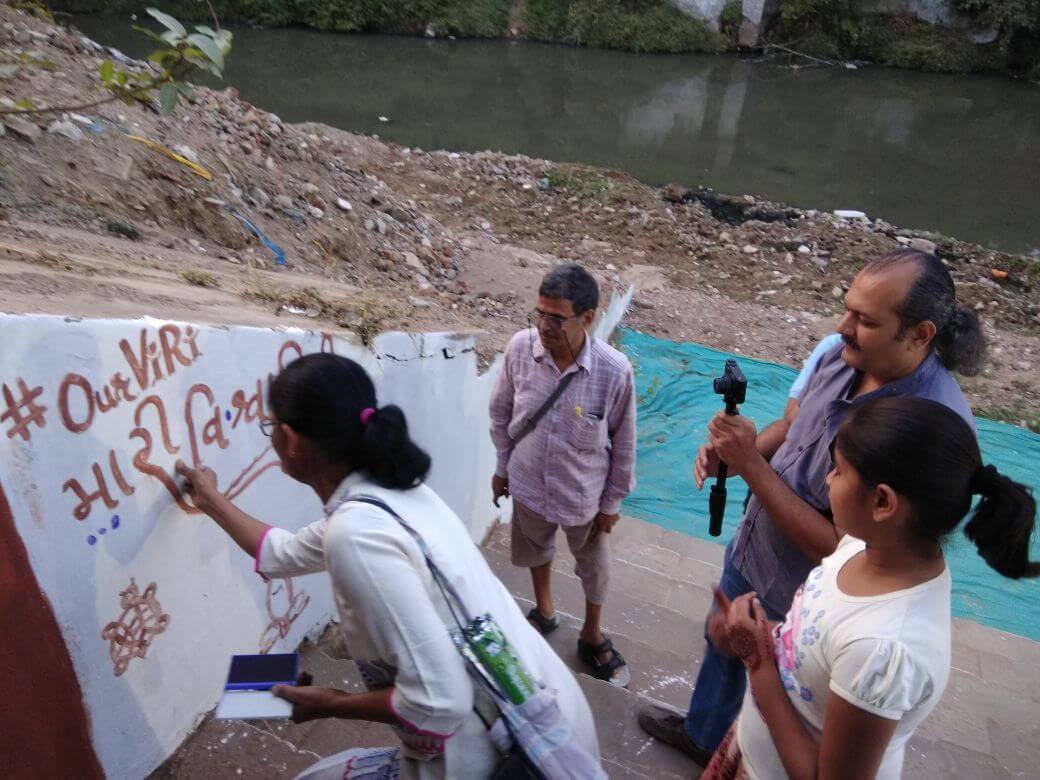
Photo: Neha Sarwate
History of the river
The Vishwamitri river, believed to be named after sage Vishwamitra, originates in the western and southern slopes of the Pavagadh hills in eastern Gujarat. The river flows westward, through Gujarat’s third largest city, Vadodara, after which it meets the two tributaries of Dhadar and Jambuva before draining into the Arabian sea via the Gulf of Khambhat. Its unique ecosystem alongside the main river corridor includes its tributaries, ravines, small streams and creeks, wetlands, oxbow lakes, and artificially created ponds. Porcupines, the common Indian civet, the jungle cat, cobras, pythons, the checkered keelback and the Bengal monitor are some of the species found in the ravines on the banks of this river. Vishwamitri is also where Class I protected and vulnerable species of the Indian crocodile (Crocodylus palustris), also known as the mugger, resides[1]. A survey by the Gujarat Forest Department in 2020 found that there were an estimated 300 muggers in the river within Vadodara’s limits[2].
The Vishwamitri ecosystem has been threatened by floods[3], and incidents of water-logging[4] and crocodiles entering Vadodara’s residential areas[5] for years. The floodplains, ravines and wetlands of a river are its natural sponges that work as flood-control mechanisms by absorbing the excess water when it overflows. The Vadodara Urban Development Authority (VUDA) building, the famous Ratri bazar, Agora mall and the ‘museum of trees’ at Vadsar which was initially a landfill are some of the constructions that have encroached upon the Vishwamitri’s ecosystem.
While the river loses space, it also loses its quality. Untreated sewage is discharged not just by industries but also from homes to flow into the river, thereby, reducing the amount of dissolved natural oxygen. The deterioration of the river and the absence of floodplains has caused severe problems for the underprivileged who reside in the low-lying areas of the city which are inundated every year. The Vishwamitri Riverfront Project was to be developed over the 17-km stretch of the 70-km-long river of which 25 km passes through Vadodara.
Confluence of people’s force
While there are several groups working towards the same cause, their approaches have been different – some took the legal route, others emphasised awareness activities and education, and a few took to events. They all, however, come together at the Yavteshwar or Kala Ghoda Ghat. Sanjay Rameshchandra Soni, of the ‘Vaho Vishwamitri Abhiyan’, one of the petitioners with Prajapati, is a wildlife activist and broker by profession. He organises clean-up drives along the Vishwamitri, and takes citizens on heritage and nature walks by the river. “When I first began doing this, there were only about 25 people on these walks. Now we have close to a thousand supporters,” he told Question of Cities.
Soni came across photographs of the temples along the ghats of the river from the British Library archives in 2006. He was moved by their beauty and grandeur, and wove them into the heritage walk which takes participants through the nine Shiva temples by the river ghats. “The idea is for people to know the heritage of this city. The more people visit, the better maintained these temples become. If the temples on the banks of the river are clean, the people will want to fight to keep the river clean too. My generation never got to cherish and enjoy the river. I want the next generation to be able to enjoy the purity and pristine quality of the river,” he explained.
Movements are built by people, around issues that matter the most to them. People put aside their differences – including intense political differences in recent years – when they joined forces for the common cause. Vadodara’s youngsters are emphasising this in the hope that the river can be restored. That’s how the ‘Voices of Vishwamitri’ group came to be, meeting at the Kala Ghoda Ghat once or twice a month on weekends for lectures by experts in hydrogeology, zoology, heritage and urban planning. The group spreads awareness and information through posters on WhatsApp and social media. Jay Vyas said that the idea behind organising these sessions is to get experts involved by taking the approach of educating interested citizens through them.
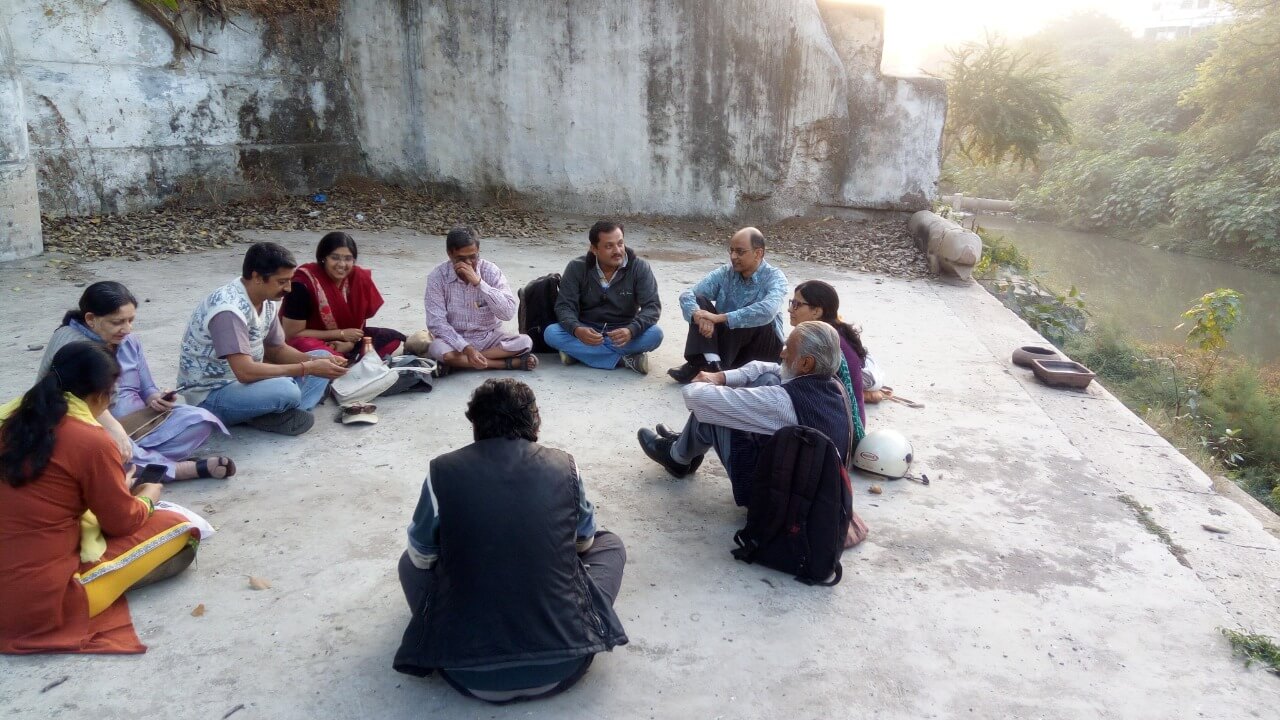
Photo: Neha Sarwate
The group also organises cultural programmes like music shows where musicians come together to sing about the history of the river and its connection to the people of Vadodara. One such show in April 2022 had 200 people in attendance. Vyas believes that people will care about what happens to the river only if they feel a connection to it, and this can be formed by learning about the river, its flora and fauna. “If one is able to identify the various animals, birds and trees around the river, one will care about them and want to protect them.”
Meanwhile, the legal battle continues. In an order on May 25 last year, the NGT directed the Vadodara Municipal Corporation to prepare a plan of “demarcation of the entire flood plain zone of the Vishwamitri river” as well as “plantation and maintaining the integrity of the river in totality” which would mean that the unauthorised structures along the river would have to be removed. In response, the municipal corporation brought machines to the banks of the river to clear foliage in July last year. This drastic move received flak from crocodile experts and activists who protested the loss of nesting spots of crocodiles. This prompted the formation of the VoV youth group. The Gujarat Pollution Control Board (GPCB) too asked the municipal corporation in August last year to stop its activities and, in May this year, issued a legal notice asking for a time-bound action plan to restore the Vishwamitri riverfront, warning the municipal commissioner of legal action.
Since her involvement in the movement, Sarwate has worked between academia and the bureaucracy. As members of CCV, she and others have written letters, attended and documented hearings, and met commissioners: “Right now, along with the GPCB, I am following up with the local authorities to figure out how to get debris out of the ravines. I call them for meetings, set up appointments, and follow up.” Sarwate said that what is on paper has not been translated on the ground. “Looking at the river as a system, not just a water course, is an important step. While this has happened on paper, it’s business as usual on the ground. It really makes you question what you think you have achieved so far,” Sarwate lamented.
What all the activists are battling is that the Vishwamitri does not meet the fate that the Sabarmati in Ahmedabad did where the riverfront work rendered the river lifeless. Vishwamitri is yet to be put on the complete path to revival but the people of Vadodara are not about to give up.
Jashvitha Dhagey developed a deep interest in the way cities function, watching Mumbai at work. She holds a post-graduate diploma in Social Communications Media from Sophia Polytechnic. She loves to watch and chronicle the multiple interactions between people, between people and power, and society and media.
Cover photo: Neha Sarwate


